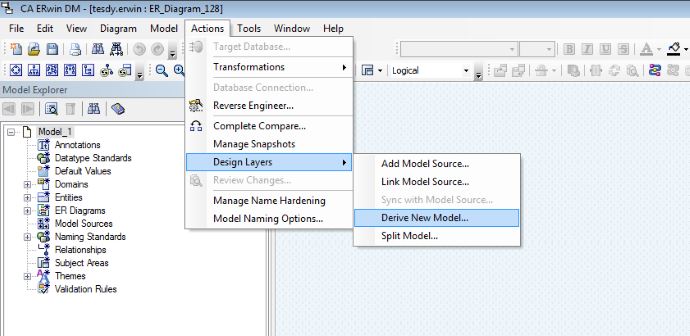

Support is included for modeling using the following databases: The Advisories Pane on the main workplace window reports a message reminding you that the intended action did not complete because of the object creation limit. For example, if you are near the limit of 25 tables and choose to partition a table, you may surpass the table limit, and the transformation operation will not complete. However, because of the limitation to 25 entities/tables per model, some transformation operations may not be possible. You can work with transformations in the Community Edition to implement design decisions, such as partitioning tables. Working with Transformations in the Community Edition Support for printing models is included in the Community Edition, although the output includes a watermark. You can open a model in *.erwin or *.erwin_tmpl format, and a SQL DDL file in the format *.sql, *.ers, or *.ddl. Save As XML, ER1, and ERT is not supported. You can save your models in the native *.erwin format or as a template (*.erwin_tmpl). In addition, you cannot copy data that is displayed on the result gird. You can export reports to HTML, but not to TEXT.

You can use the new reporting tool, Report Designer to generate and view reports. To avoid problems, work with a database that has fewer than 25 tables. This may result in problems in the Complete Compare Resolve Differences dialog, where objects and properties between the models will not match. Note: If you are working with a database as part of the compare process, only the first 25 tables are reverse engineered to the model used during the compare. In addition, demand loading of databases and Alter Script generation are not supported. The "Finish" button is disabled in the Resolve Differences dialog. You can use Complete Compare features to evaluate and compare models, but you cannot commit changes you make in the Complete Compare wizard to the models you compare. For example, if you reverse engineer a DB2/LUW script that contains 25 tables and a materialized view, the temporary table used to create the materialized view will cause you to exceed the allowed table limit for the model. Note: Some operations that include the creation of temporary tables may also result in exceeding the allowed table limit. For other databases, a warning message displays, stating that the import feature is disabled. For Oracle and SQL Server, the reverse engineer process stops after creating 25 tables in the new model. If you attempt to reverse engineer a script or a database with more than 25 tables, or attempt to open a model with more than 25 tables, a warning message displays. There is no restriction on the number of views you can create. You can reverse-engineer, import using Metadata Integration (MITI) bridges, or create up to 25 entities/tables per model. Most of the basic features are available, with limited access to the following features: 25 Entities/Tables Per Model It is designed to help Data Architects learn data modeling techniques, create simple data models, and learn about the design and maintenance of a production database. The Community Edition includes a limited number of features from the main product.


 0 kommentar(er)
0 kommentar(er)
